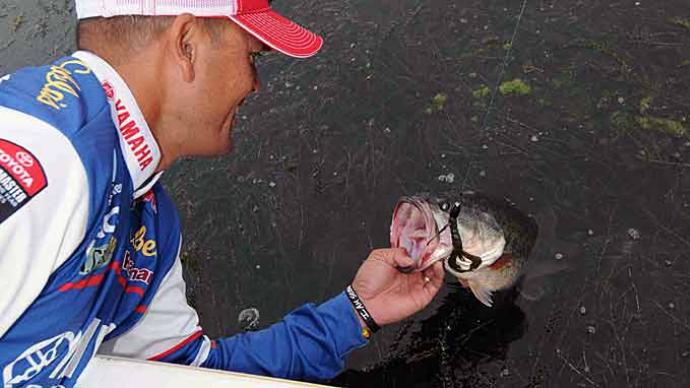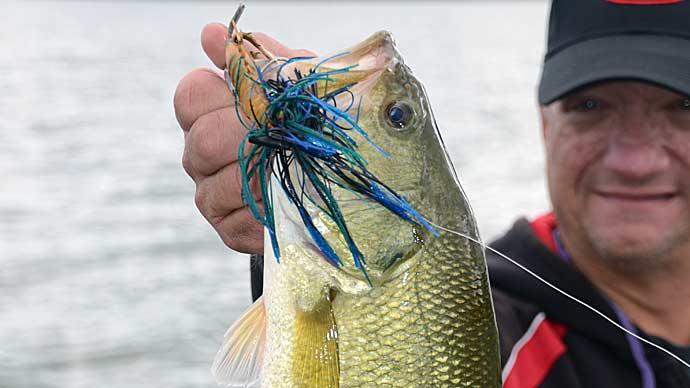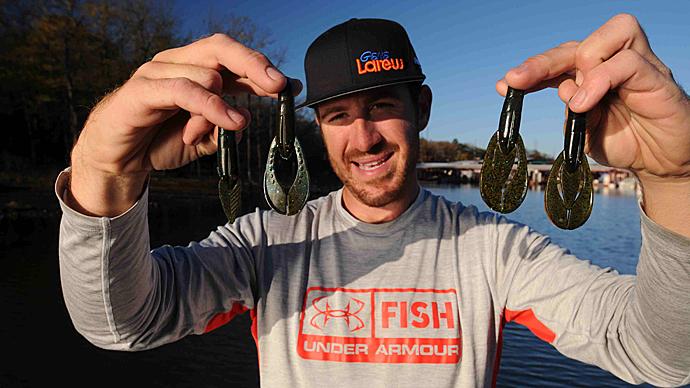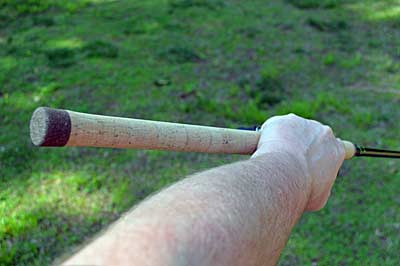
Bass anglers love fishing visible targets. Placing a lure precisely and quietly next to one is its own reward. But the biggest is a bass, which are ambush feeders. Many lurk around these cover pieces, waiting for their next meal to swim, crawl or fall into their mouth.
Several casting styles have been developed to create these pinpoint presentations. The best known is flipping, which legendary West Coast angler Dee Thomas brought to the mainstream in the mid-1970s. It uses a long rod, and a short line length to pendulum lures into small spots, whether along the trunk of a flooded tree, a small hole in an expansive mat of aquatic vegetation, or next to a stand of tulles. Then there are roll casts, a staple presentation of longtime tournament, TV, and spinnerbait angler Jimmy Houston. They provide accurate presentations from a farther distance than flipping. But instead of putting your lure directly on the spot, they work better when your lure goes beyond the target and then is brought back to it, often with a bit of contact.
Pitching begins with an underhand swing of your rod that propels your lure directly to a target. Sometimes the lure starts in your opposite hand. Other times it's free-swinging. Pitching combines the best of both worlds: It has all the sneakiness and accuracy of flipping, but pitching can be done from near the distance of roll casts. That's handy when bass are alert in extremely shallow or clear water or facing heavy fishing pressure. And pitching lets, you cover more water, mainly when a high-speed reel is used to retrieve pitches quickly that come up empty.
Proficient pitching makes you a better bass angler. But reaching that skill level takes effort, including selecting the proper equipment, perfecting your form, and practicing, at least in the beginning. Here’s how to balance all of those and become better at pitching.
Choose the correct rod and reel.
Fishing rods are tools. Select the best length, action, and power for how and where you're fishing, and watch your catches improve. But while the concept is simple, it's easy to get lost in the details.
Pitching has traditionally shared billing with flipping when it comes to rods. These combo sticks, which sport extremely fast actions — only bending at the tip — favor flipping. They take effort to load, even with a heavy lure, forcing you to compensate by pushing a pitch with your entire arm. A proper pitching rod sports a slightly slower action, requiring less angler effort to create flex further into the blank. That stored energy is released on the forward swing, sending your lure toward its target. Just remember to stop it right before it hits the water. That will create a quiet entry.
When choosing a pitching rod, look for one that flexes in the top 20% of its blank if you’re having trouble finding one with that much flex, set your search on slightly less expensive rods. Even if their action is labeled fast, the materials used to build them often create a slower acting action. You want it to measure 7 feet or slightly longer, which will help with pitching distance. A full or split grip is your choice.
Your pitching rod should have a heavy power, which the combo rods use. Power has little to do with a rod’s castability. Instead, it has all to do with the size of lures, line, and fish it can handle. Ultralight power rods, for example, are for lures that weigh less than 1/8 ounce, 2- to 6-pound test lines, and small panfish and trout. On the other hand, a heavy-power rod will handle a big jig that’s tied to big line and bit by big bass.
While baitcasting rods are often selected for pitching, the technique can be done with spinning rods. Swinging small Texas-rigged soft-plastic worms around boat docks, for example, is a great way to catch pressured bass in early summer. Pitching principles are the same with either rod, though, with spinning rods, you must master releasing the line at the proper instant with your finger instead of your thumb. But you don’t have to worry about backlashes.
Slim down your line
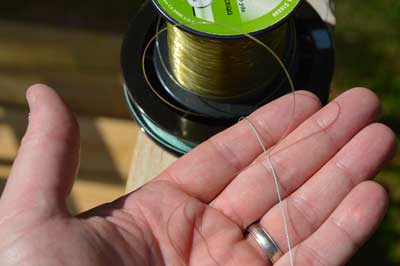
You’re fishing in and around heavy cover when you turn to pitching. And that demands a strong line, which typically brings a relatively large diameter, especially if you spool your reel with monofilament or fluorocarbon. But like a rod with too fast action, it can be hard to handle, affecting the quality of your pitches. So a thinner diameter line is a better option.
Thinner lines don’t always mean weaker. While that's the case with most fluorocarbon and monofilament lines — though some manufacturers make small-diameter options — braided line packs more strength in less diameter. That’s only the beginning of how braid is best for pitching. It is also more subtle, reducing tangles and flowing off your reel’s spool and easily through your rod’s line guides. All this leads to less effort to launch your lure, allowing you to focus on putting it on target and preparing for a strike.
Line that’s packed tightly on your reel’s spool behaves better, too. So, if you notice yours becoming looped and loose from reeling in slack, turn toward open water and fire off a long cast. Then pinch your line ahead of the reel, and wind it back on the spool under tension. That will saturate it with water, too, contributing to smoother operation.
If you're pitching with a baitcasting reel, its brakes must be correctly set. With it on a rod and tied to a lure, disengage the reel’s clutch and loosen its mechanical brake until the lure falls freely. Then tighten it to the point where the lure barely falls. The magnetic cast control should be a final adjustment to combat current conditions. For example, if the wind kicks up, add a bit more magnetic brake. This method won't eliminate backlashes. Nothing will. But it will significantly reduce them.
Break your handle
Concentrate on your form once you've found the gear that functions best for pitching. First, you'll need to perfect your timing. That includes pausing an instant at the apex of your backswing to allow the lure a chance to load your rod if your lure is hanging free fully. Let your rod load slightly before letting go if it's in your opposite hand. Be careful of the hook, however. Then you need to find the perfect point to release your lure during your forward swing. That’s usually just as your lure is at its lowest point.
Beyond timing, the best thing you can do is get your rod's handle away from your forearm. This is easiest done by rotating your hand, so the reel's handle faces down. Then kick the rod's butt outside your forearm, and keep it through the entire pitch. The rod's tip is pointed down and will rise above your forearm.
Fish heavier lures
Momentum is behind the longest and most accurate pitches. But form will only take them so far. You need a little help, too. And you’ll find it in heavier lures.
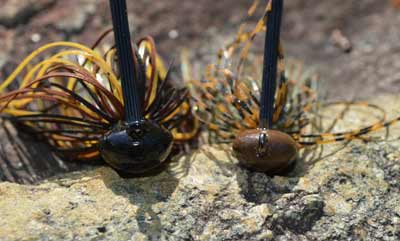
Heavier lures pitch better for a couple of reasons. First, they load your rod further and easily pull the line from your reel. And they take less effort to get moving. Achieving that with lightweight lures often requires pushing your rod with your entire arm — the same situation as using a rod with too fast of an action. And that gets everything out of whack.
Heavier lures also are easier to keep closer to the water’s surface. They can be released earlier in the forward portion of your pitch when they are closest to the water’s surface. And they’ll have enough momentum to carry that line further from you. The low trajectory makes it easier to put your lure under overhanging cover such as trees, bushes, and docks.
You don’t have to add much weight to see an improvement. Tying on a 3/8-ounce jig, for example, rather than a 1/4-ounce one is enough. And it’s the same principle when you’re pitching a Texas-rigged soft-plastic lure: Use a slightly heavier bullet weight or slightly larger bait.
Practice, practice, practice
Your family may think you’re weird, especially if they don’t fish. And your neighbors may peak through their curtains at you, wondering what’s happening, especially if there’s snow on the ground. But heading to your yard to work on your pitching is essential.
You can use anything in your yard, such as overhanging bushes, picnic tables, planters, or low tree limbs, as a target for your pitches. It’s even more helpful to elevate yourself slightly, mimicking how you stand off the water in a boat. Then start trying to hit targets with a lure — a jig with the hook cut off works best. The more natural pitching movements become to you, the better you’ll be at it.


